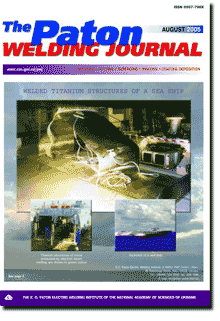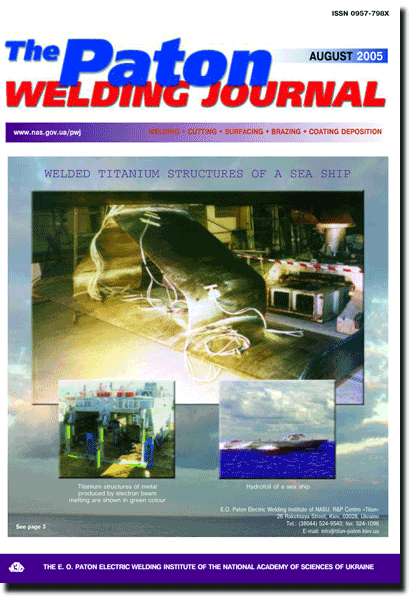

| SCIENTIFIC AND TECHNICAL | |
|
Paton B.E. Current achievements of the E.O. Paton Electric Welding Institute in the field of welding and related processes |
2 |
| Makhnenko V.I., Velikoivanenko E.A., Rozynka G.F. and Pivtorak N.I. Effect of non-relaxed residual stresses on load-carrying capacity and residual life of welded joints of pipings and equipment of nuclear power engineering objects | 18 |
| The non-relaxed residual stresses in the presence of crack-like defects can influence greatly the decrease in load-carrying capacity and safe service of welded joints of pipings and elements of equipment of nuclear power engineering objects. This influence is growing largely in degradation of characteristics of resistance to brittle fracture KIC, KC and growth of corrosion cracks KISCC in the process of service (repairs). | |
| Nazarenko O.K., Nesterenkov V.M. and IlyushenkoR.V. Weldability of aircraft aluminuim alloys of great thickness in EBW | 25 |
| Weldability of high-strength aluminium alloys 2024-T351 and 7010-T7651 100 mm thick in electron beam welding has been studied. It is shown that EBW can be used to produce sound welded joints with a high static strength and sufficiently reliable service properties. | |
| Kuchuk-Yatsenko S.I., Kachinsky V.S. andIgnatenko V.Yu. MIAB welding of solid parts | 31 |
| A new method to control the arc motion over the entire cross-sectional area of solid parts in magnetically-impelled arc butt (MIAB) welding is considered. Features of welded joint formation in MIAB of solid parts have bean studied. Technology has been developed of welding the above-mentioned parts of up to 32 mm diameter. | |
| Lobanov L.M., Pivtorak V.A., Savitsky V.V.,Tkachuk G.I. and Kiyanets I.V. Express control of quality and stressed state of welded structures using methods of electron shearography and speckle-interferometry | 35 |
| Technology and procedures of non-destructive quality control and study of stressed state using electron shearography and speckle-interferometry are presented. Examples of application of quality control and results of determination of residual stresses in structure elements are given. | |
| Zamkov V.N. and Prilutsky V.P. Methods for welding titanium alloys | 41 |
| Ingenious methods for fusion welding of titanium alloys, developed by the E.O. Paton Electric Welding Institute, are described. Advantages of the application of halide fluxes developed by the Institute for electroslag, arc and electron beam welding are shown. | |
| Shelyagin V.D., Krivtsun I.V., Borisov Yu.S.,Khaskin V.Yu., Nabok T.N., Siora A.V., Bernatsky A.V., Vojnarovich S.G., Kislitsa A.N. and Nedej T.N. Laser-arc and laser-plasma welding and coating technologies | 44 |
| Peculiarities of processes occurring in the case of combined utilisation of laser beam and consumable-electrode arc or plasma jet are considered. Fundamentally new approaches have been developed for one- and multipass hybrid laser-arc welding, as well as combined and hybrid laser-microplasma deposition of coatings (including diamond and diamond-like thin coatings). Advantages of the new hybrid (combined) processes are shown in comparison with the available laser and arc ones. | |
| Ryabtsev I.A. Electrode materials for mechanized arc surfacing | 50 |
| The paper describes the welding-technological characteristics of the main groups of surfacing materials for mechanized surfacing processes. The composition, hardness and purpose are given for the most widely used in industry solid and flux-cored wires, flux-cored, cold-rolled and sintered strips developed at the E.O. Paton Electric Welding Institute. | |
| Petushkov V.G., Dobrushin L.D., Volgin L.A.,Illarionov S.Yu. and Shlensky P.S. Novelties in explosion cutting of metalwork | 54 |
| New designs of extended cumulative charges resistant to electrochemical corrosion and with high cutting ability applicable for ground and underwater operations are developed. Efficiency of a number of shielding media providing suppression of a harmful side effect of the explosion is experimentally studied. Application of EC technology under water is presented. | |
| Sabadash O.M. and Khorunov V.F. Materials and technology for flux brazing and soldering of aluminium and aluminium to steel | 62 |
| Peculiarities of brazing of aluminium using high-temperature fluxes of the KДAlДSi/F system, as well as soldering using low-temperature fluxes, containing a new class of activators, i.e. complex tetrafluoborates (TFB) of metals Pb(II), Zn(II) and Cd(II) with nitrogen-containing bases, such as benzatriazole and morpholine, characterised by high reactivity, have been studied. Chemical interaction of aluminium with salt melts of the KДAlДSi/F ternary system results in formation of liquid alloy AlДSi at the interface. This alloy greatly improves spreading and filling of capillary gaps with brazing filler alloys, and it can independently perform the function of a brazing filler alloy. Reactive flux FAF540 is successfully applied for joining aluminium alloys containing up to 0.7 % Mg, as well as aluminium to stainless steel. In low-temperature soldering, the metal coatings are deposited from a composition of complex TFB on the surface of aluminium parts being soldered. The coatings can be readily wetted and dissolved by low-melting point solders and improve formation and properties of the aluminium joints. | |
| Yushchenko K.A. and Derlomenko V.V. Materials weldability criteria | 68 |
| The new definition of weldability implies that it is a property of material, which is determined by the degree of degradation and can be evaluated as an integrated indicator. Examples of degradation of some materials characterising their weldability are given. Premises for development of a modern concept of weldability in terms of its control are considered. | |
| NEWS | 71 |
(You are viewing the simplified file contents)
The cost of subscription/purchase order journals or individual articles
| Journal/Currency | Annual Set | 1 issue printed |
1 issue |
one article |
| TPWJ/USD | 384 $ | 32 $ | 26 $ | 13 $ |
| TPWJ/EUR | 348 € | 29 € | 24 € | 12 € |
| TPWJ/UAH | 7200 UAH | 600 UAH | 600 UAH | 280 UAH |
| AS/UAH | 1800 UAH | 300 UAH | 300 UAH | 150 UAH |
| AS/USD | 192 $ | 32 $ | 26 $ | 13 $ |
| AS/EUR | 180 € | 30 € | 25 € | 12 € |
| SEM/UAH | 1200 UAH | 300 UAH | 300 UAH | 150 UAH |
| SEM/USD | 128 $ | 32 $ | 26 $ | 13 $ |
| SEM/EUR | 120 € | 30 € | 25 € | 12 € |
| TDNK/UAH | 1200 UAH | 300 UAH | 300 UAH | 150 UAH |
| TDNK/USD | 128 $ | 32 $ | 26 $ | 13 $ |
| TDNK/EUR | 120 € | 30 € | 25 € | 15 € |
AS = «Automatic Welding» - 6 issues per year;
TPWJ = «PATON WELDING JOURNAL» - 12 issues per year;
SEM = «Electrometallurgy Today» - 4 issues per year;
TDNK = «Technical Diagnostics and Non-Destructive Testing» - 4 issues per year.


